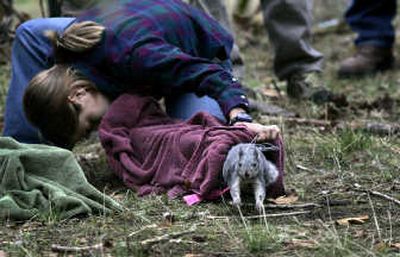Rare squirrels released at base

FORT LEWIS, Wash. – The seven newest subjects in a Fort Lewis survival test hightailed it into the post’s oak woodlands Tuesday without looking back. After a night trapped in a truck bed lined with oak leaves, they fled into the wild to gather seeds, nuts and mushrooms and sleep in trees.
If they’re lucky, they’ll escape potential killers and find mates. If not, their only remains might be piles of fur and the radio transmitter collars with which they were fitted before scientists set them free.
The seven are Western gray squirrels, the state’s largest native tree squirrels, extremely rare rodents whose claim to fame is that their sole remaining Western Washington stronghold could be divided by the proposed cross-base highway.
Before seven newcomers were added, biologists estimated that no more than 50 Western gray squirrels made their home on Fort Lewis and adjacent areas of McChord Air Force Base.
Tuesday’s releases were the first step in a five-year, $500,000 effort to enhance a squirrel population that experts say could otherwise be doomed.
The goal is to boost the population and expand the genetic diversity of a group otherwise vulnerable to disease, wildfire or other catastrophe.
Matt Vander Haegen, a state Department of Fish and Wildlife research scientist, oversees the work, also backed by Fort Lewis and largely funded by the state Department of Transportation.
Wildlife biologists working on the project said they don’t know how the project might affect the proposed highway, which would link Interstate 5 and Spanaway.
“Gosh, that’s so wrapped up in politics,” Vander Haegen said. “We’re just trying to keep the (squirrel) population alive.”
At the Tahoma Audubon Society, whose members unsuccessfully sought a federal endangered species listing for the squirrel, executive director Bryan Flint said the state’s new effort underscores the significance of the critter and its habitat.
“It’s really significant, really pristine, and we want to keep it that way,” he said.
Western gray squirrels are larger, showier and more reclusive than their more familiar cousins, the Eastern gray squirrels commonly seen in backyards and city parks around the Puget Sound region.
Eastern gray squirrels are an invasive species and were introduced to Washington in 1925. One way to distinguish between the two is to look for the wash of brown coloring typical of Eastern gray squirrels. In contrast, Western gray squirrels are exclusively salt-and-pepper gray.
Tuesday’s releases occurred in two open areas within Holden Woods, north of the post’s east gate and near Spanaway. The seven set free were trapped Monday near Twisp in Okanogan County, one of two places in Washington where Western gray squirrels are still found. The other is in Klickitat County.
In 1993, state officials listed Western gray squirrels as threatened with extinction in Washington, in part because of the disappearance of the native Oregon white oak forests like the ones on Fort Lewis.
Human development has destroyed most of the old oak stands, which in the South Sound typically surround native short-grass prairies, also vanishing.
The 86,000-acre Fort Lewis is home to 90 percent of the remaining relatively undisturbed South Sound prairies. It’s a habitat important not only to squirrels, but also to other rare creatures including butterflies (Taylor’s checkerspot and the Mardon skipper), Mazama pocket gophers and streaked horned larks, a ground-nesting bird. All also are found on post, said Mary Linders, a biologist who works on Fort Lewis to revive their dwindling populations.
While federal officials have turned down requests to protect Western gray squirrels under the Endangered Species Act, other creatures are likely candidates. And because a federal listing could limit Army training on post, Fort Lewis several years ago made a commitment to conservation, Linders said.
“Our primary focus is ecosystem management,” said David Clouse, the fort’s fish and wildlife program manager. Much of the effort has focused on Scotch broom, the invasive weed that 10 years ago dominated thousands of acres of the post’s prairies. The broom overwhelmed open spaces squirrels need and likely squeezed the remaining population, biologists said.
The Fort Lewis squirrel enhancement project is modeled in part on similar efforts in Virginia and Maryland, where the Delmarva fox squirrel was successfully reintroduced beginning in 1968. The Fort Lewis project is believed to be the first scientific effort to augment an existing population, Linders said.
Besides four male and three female squirrels released Tuesday, biologists plan to add another small group next year from Klickitat County. Besides the radio collars, the newcomers’ ears are tagged with identification numbers.
A team of researchers will track the squirrels to see how they use their digs, whether they mate and reproduce, and what happens when they encounter Eastern gray squirrels, among other things.
Eventually, researchers expect to learn enough about the squirrels to influence habitat management. In the meantime, if anybody needs to recapture surviving subjects, scientists know how to bait the traps.
“Whole walnuts,” Vander Haegen said. “They have a sweet tooth for walnuts.”